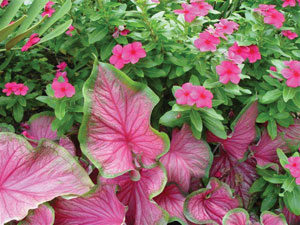12/15/2009
Colorful Caladiums
Terri Cantwell

It appears to be a productive year in Lake Placid, Florida—the Caladium Capital of the World. Orders for bulbs (tubers) have been placed and shipments are going out. Each year there are potential problems with caladium orders and culture that needs to be reviewed. Some of those potential problems include the following.
Ordering
We suggest placing your orders for caladiums early because once harvesting begins and yield data is generated, there may not be availability in some varieties. For example, once we know a variety did not produce well, we will hesitate to accept any additional orders for that variety. Orders placed early generally get first priority. Sometimes, substitutions are necessary either by size or variety. Caladiums are a seven-month crop, and in Florida, a lot can happen. Your supplier should call and let you know if there will be a substitution and give you some options.
Please understand that caladiums require six weeks of curing time in the grower’s warehouse before they can be shipped. The longer the bulb has been harvested, the quicker it will force for the greenhouse grower. You don’t always save time by ordering bulbs for early delivery.
Shipping
Caladiums are a tropical plant. They cannot be shipped by an unheated carrier until the nighttime temperatures are 55F (13C) or higher. UPS and FedEx will not guarantee the bulbs will not be exposed to cold temperatures. The degree of cold damage depends upon how long they were exposed to cold temperatures. If you can’t ship by a heated truck, then ask your supplier to watch the weather for a warm week. Sometimes all our UPS shipments go out the same Monday in January or February if we can catch a few days of warm weather in the north.
Receiving
Every year we receive a few complaints of cold damage even with heated trucks. This usually occurs because the boxes are unloaded and left outside for a few hours in 30F to 40F (-1C to 5C) weather. If you aren’t at your facility when the truck arrives, whether it is a heated truck or UPS, please make sure the boxes are moved into the greenhouse. Unpack the boxes within a few days and put them in some type of vented trays until you are ready to pot. Caladium bulbs harvested and shipped early contain a lot of moisture and therefore require careful handling after delivery.
General Growing
There is a lot of information out in the industry that makes growing caladiums appear complicated and costly. That’s unfortunate because it is a relatively simple crop to grow. Water, heat and light are the basic requirements. Moderate light levels (2,500-4,500 footcandles), especially in the North, are fine for all varieties. Light isn’t necessary until the plants are well spiked. Stacking pots, covering them with plastic, or growing on racks are all good methods for forcing.
Heat is the primary issue. For best forcing, keep the day and night temperatures above 70F (21C). Damage will not occur in the 60F to 69F range (15C to 20C), but you will increase forcing time and lose valuable bench space.
Fertilize minimally; once a week with liquid feed is sufficient. White Christmas and Candidum are very good indicator plants for over fertilization; brown spots on the leaves are the red flag to watch for. Use of fungicides, pesticides, excess fertilizer and growth regulators are not necessary in most growing situations. Call your supplier if you need recommendations on the size and number of bulbs by pot size, de-eyeing, full sun varieties and related finishing issues.
Terri Bates Cantwell is a third-generation caladium farmer for Bates Sons & Daughters, Inc. in Lake Placid, Florida. She and her sister Sheri also own Capital Caladiums Company, a pre-finished caladium greenhouse operation.